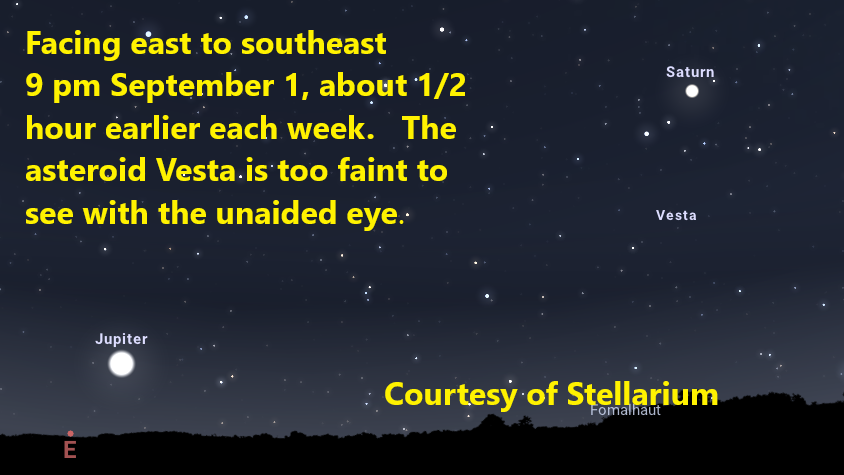FALL ARRIVES; PLANETS APPEAR
I haven’t discussed viewing the planets very much in recent editions of this blog. This is because they have been heavily concentrated in the morning sky, and although I don’t mind waking up early to see them every now and then, I am aware that most of my readers value their sleep! However, as Earth continues its never-ending circuit around the Sun, we will finally start to get some good visibility of the bright planets this fall. Viewing the brighter planets is fun and easy, whether you have a telescope or not.
Early risers can try to get a last glimpse of Venus during the first week or two of September. Find a spot with an open view close to the eastern horizon and go out about 6 am. Binoculars might help you spot starlike Venus low in the east, amidst the Sun’s glare. Venus will soon be lost to view as it appears more and more on the far side of the Sun as seen from Earth, a phenomenon called superior conjunction. For about the next three months, our sister planet will be lost to view, until it appears as the “evening star” this winter and spring. The counterpart of this occurred this past January, when Venus went through inferior conjunction, passing between the Earth and Sun. As mentioned in my January 2022 blog post, these comings and goings were noted by the ancient Maya civilization and noted in the famous Dresden Codex.
The innermost planet, Mercury, goes through the same cycle as Venus, but much more quickly, since it is closer to the Sun and orbits more rapidly. It will go through inferior conjunction on September 22nd, so neither Mercury nor Venus can be observed well this month. October will feature a good appearance of Mercury, albeit in the predawn sky.
Since the outer planets are farther from the Sun, it is possible for the Earth to pass between them and the Sun, an event called opposition. This is the best time to view these planets, as they are closest to the Earth, appear their brightest, and being opposite the Sun in the sky, are visible all night long, rising around the time the sun sets and setting when it rises. Saturn was in opposition on August 14 and Jupiter will be on September 26, so both can be found in the eastern evening skies this month, as can be seen in the chart below. Both of these giant planets have cloudy atmospheres that reflect the Sun’s light well. Although Saturn appears as about as bright as the brighter stars in the sky, Jupiter outshines them all by a large margin since it is closer to the Sun and Earth. It so happens that this year, Jupiter is closest to the Earth at nearly the same time that it is also closest to the Sun, so the giant planet will shine brighter in 2022 than it will again for almost fifty years. This will probably get a lot of media attention, but to be honest, the difference from last year’s or next year’s opposition will be so slight as to not be noticeable to the human eye.
Because Mars is closer to Earth, the difference between near and far oppositions is significant- something we will discuss later this fall and during the winter, as it does not reach opposition until December 8. To see the Red Planet, you currently need to stay up fairly late- it rises north of east near midnight in early September and about 11 pm at the end of the month.

Our September 3 Gateway to the Stars program will feature a chance to learn about the effects of light pollution upon wildlife as well as the night sky. Join Jean Favara from the St. Louis Audubon Society and Don Ficken from Dark Sky Missouri as they discuss these important issues. Since animals have different eye designs than humans do, they experience light differently. Children attending this program will build and bring home their own spectroscope, which breaks up light into its component colors. The program will take place in the Park’s Education Classroom at 6:30 pm on Saturday, September 3. Weather permitting, it will be followed by free telescope viewing of Saturn, the Moon, and Jupiter, out on the Park’s West Entrance Plaza.
